1993 BUICK PARK AVENUE wiper blades
[x] Cancel search: wiper bladesPage 95 of 340
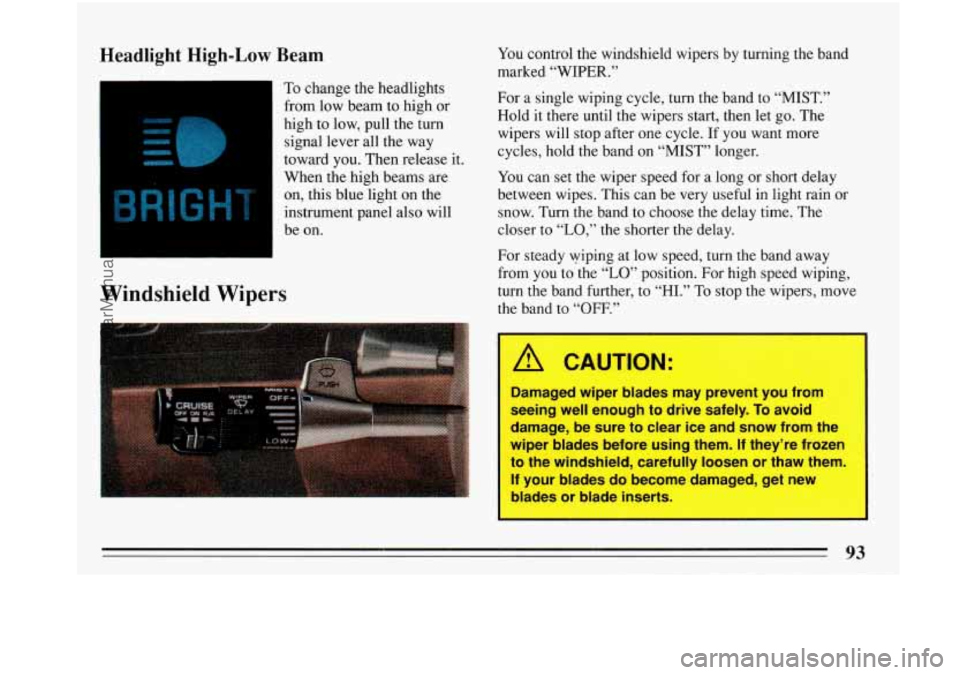
Headlight High-Low Beam
To change the headlights
from low beam to high or
high to low, pull the turn
signal lever. all the way
toward you. Then release it.
When the high beams are
on, this blue light on the
instrument panel also will
be on.
R 1J H
Windshield Wipers
You control the windshield wipers by turning the band
marked
“WIPER.”
For a single wiping cycle, turn the band to “MIST.”
Hold it there until the wipers start, then let go. The
wipers will stop after one cycle. If you want more
cycles, hold the band on “MIST” longer.
You can set the wiper speed for a long or short delay
between wipes. This can be very useful in light rain or
snow. Turn the band to choose the delay time. The
closer to
“LO,” the shorter the delay.
For steady wiping at low speed, turn the band away
from you to the
“LO” position. For high speed wiping,
turn the band further, to “HI.”
To stop the wipers, move
the band to
“OFF.”
A CAUTION:
Damaged wiper blades may prevent you from
seeing well enough to drive safely.
To avoid
damage, be sure to clear ice and snow from the
wiper blades before using them.
If they’re frozen
to the windshield, carefully loosen or thaw them.
If your blades do become damaged, get new
blades or blade inserts.
93
ProCarManuals.com
Page 186 of 340
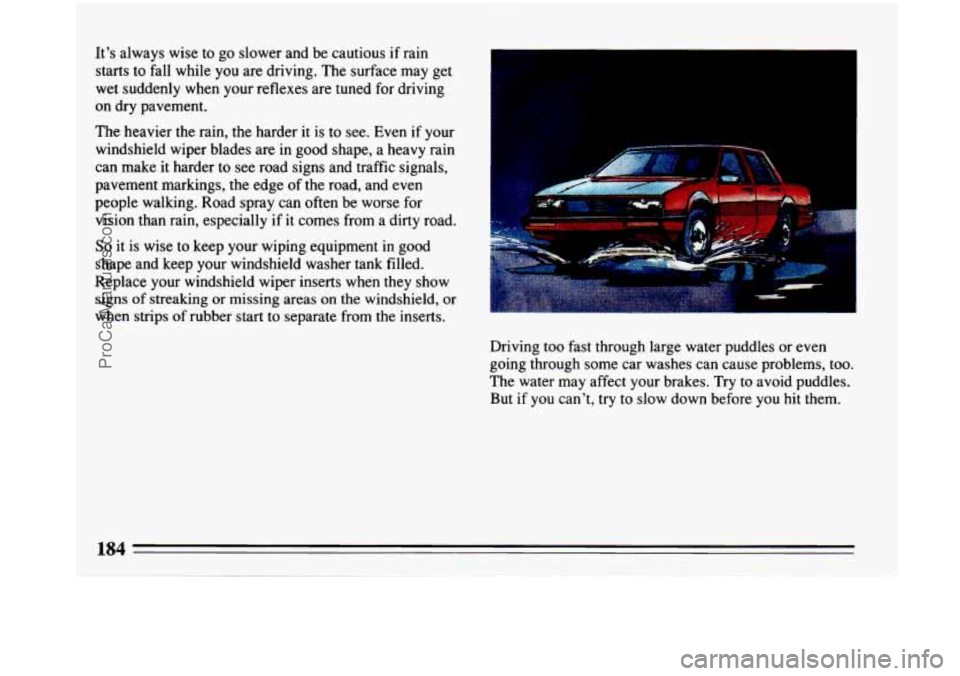
It’s always wise to go slower and be cautious if rain
starts to fall while you are driving. The surface may get
wet suddenly when your reflexes are tuned
for driving
on dry pavement.
The heavier the rain, the harder
it is to see. Even if your
windshield wiper blades are
in good shape, a heavy rain
can make it harder to see road signs and traffic signals,
pavement markings,
the edge of the road, and even
people walking. Road spray can often be worse for
vision than rain, especially
if it comes from a dirty road.
So it is wise to keep your wiping equipment in good
shape and keep your windshield washer tank filled.
Replace your windshield wiper inserts when
they show
signs
of streaking or missing areas on the windshield, or
when strips of rubber
start to separate from the inserts.
Driving too fast through large water puddles
or even
going through some car washes can cause problems, too.
The water may affect your brakes. Try to avoid puddles.
But if you can’t, try to slow down before you hit them.
ProCarManuals.com
Page 192 of 340
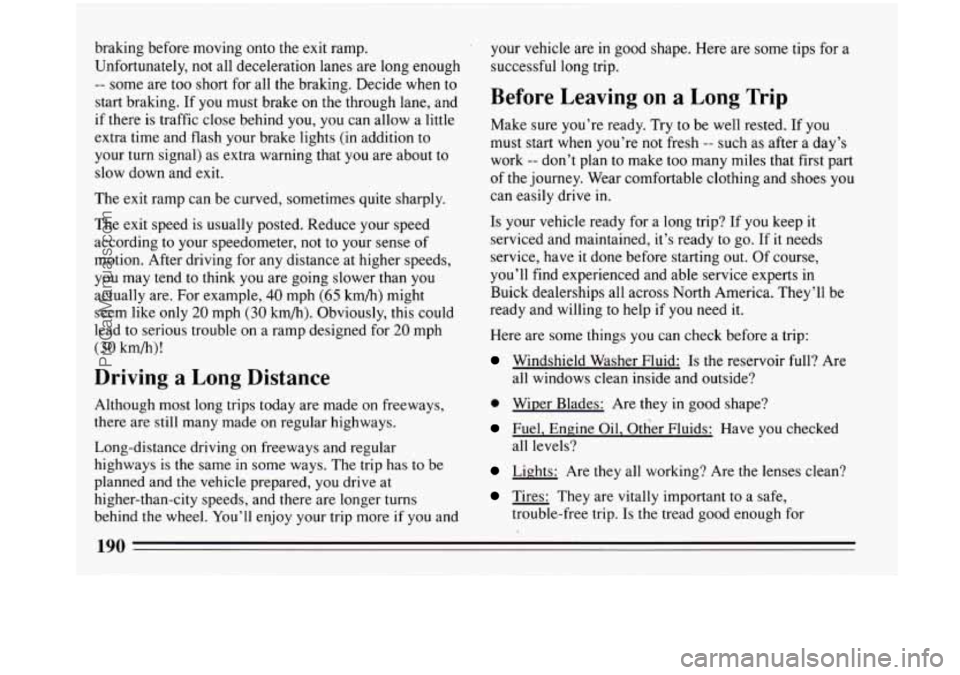
braking before moving onto the exit ramp.
Unfortunately, not all deceleration
lanes are long enough
-- some are too short for all the braking. Decide when to
start braking. If you must brake on the through lane, and
if there is traffic close behind
you, you can allow a little
extra time and flash your brake lights (in addition to
your turn signal) as extra warning that you are about to
slow down and exit.
The exit ramp can be curved, sometimes quite sharply.
The exit speed is usually posted. Reduce your speed
according to your speedometer, not to your sense of
motion. After driving for any distance at higher speeds,
you may tend
to think you are going slower than you
actually are. For example,
40 mph (65 km/h) might
seem like only
20 mph (30 km/h). Obviously, this could
lead to serious trouble on a ramp designed for
20 mph
(30 km/h)!
Driving a Long Distance
Although most long trips today are made on freeways,
there are still many made on regular highways.
Long-distance driving on freeways and regular
highways
is the same in some ways. The trip has to be
planned and
the vehicle prepared, you drive at
higher-than-city speeds, and there are longer turns
behind the wheel. You’ll enjoy your trip more
if you and your vehicle
are in good shape. Here are some tips for a
successful long trip.
Before Leaving on a Long Trip
Make sure you’re ready. Try to be well rested. If you
must start when you’re not fresh -- such as after a day’s
work
-- don’t plan to make too many miles that first part
of the journey. Wear comfortable clothing and shoes you
can easily drive
in.
Is your vehicle ready for a long trip? If you keep it
serviced and maintained, it’s ready to go. If it needs
service, have it done before starting out. Of course,
you’ll find experienced and able service experts in
Buick dealerships all across North America. They’ll be
ready and willing to help if
you need it.
Here are some things you can check before a trip:
Windshield Washer Fluid: Is the reservoir full? Are
all windows clean inside and outside?
0 Wiper Blades: Are they in good shape?
Fuel, Engine Oil, Other Fluids: Have you checked
Lights: Are they all working? Are the lenses clean?
Tires: They are vitally important to a safe,
all levels?
trouble-free trip. Is
the tread good enough
for
ProCarManuals.com
Page 283 of 340
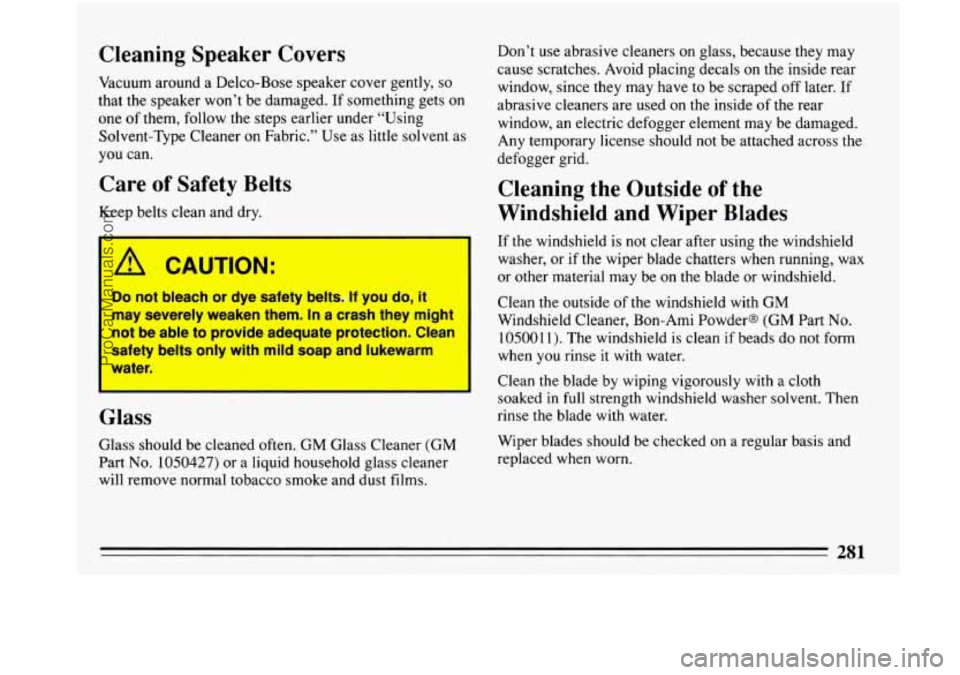
Cleaning Speaker Covers
Vacuum around a Delco-Bose speaker cover gently, so
that the speaker won’t be damaged. If something gets on
one
of them, follow the steps earlier under “Using
Solvent-Type Cleaner on Fabric.” Use as little solvent as
you can.
Care of Safety Belts
Keep belts clean and dry. Don’t
use abrasive cleaners on glass, because they may
caus.e scratches. Avoid placing decals on the inside rear
window, since they may have to be scraped
off later. If
abrasive cleaners are used on the inside of the rear
window, an electric defogger element may be damaged.
Any temporary license should not be attached across the
defogger grid.
Cleaning .the Outside of the
Windshield and Wiper Blades
A CAUTION:
Do not bleach or dye safety belts. If you do, it
may severely weaken them. In a crash they might
not be able to provide adequate protection. Clean
safety belts only with mild soap and lukewarm
I I
Glass
Glass should be cleaned often. GM Glass ueaner (GM
Part
No. 1050427) or a liquid household glass cleaner
will remove normal tobacco smoke and dust films. If
the windshield is not clear after using the windshield
washer, or if the wiper blade chatters when running, wax
or other material may be
on the blade or windshield.
Clean the outside of the windshield with GM
Windshield Cleaner, Bon-Ami Powders (GM Part
No.
105001 1). The windshield is clean if beads do not form
when you rinse it with water.
Clean the blade by wiping vigorously with a cloth
soaked in
full strength windshield washer solvent. Then
rinse the blade with water.
Wiper blades should be checked on
a regular basis and
replaced when worn.
ProCarManuals.com
Page 325 of 340
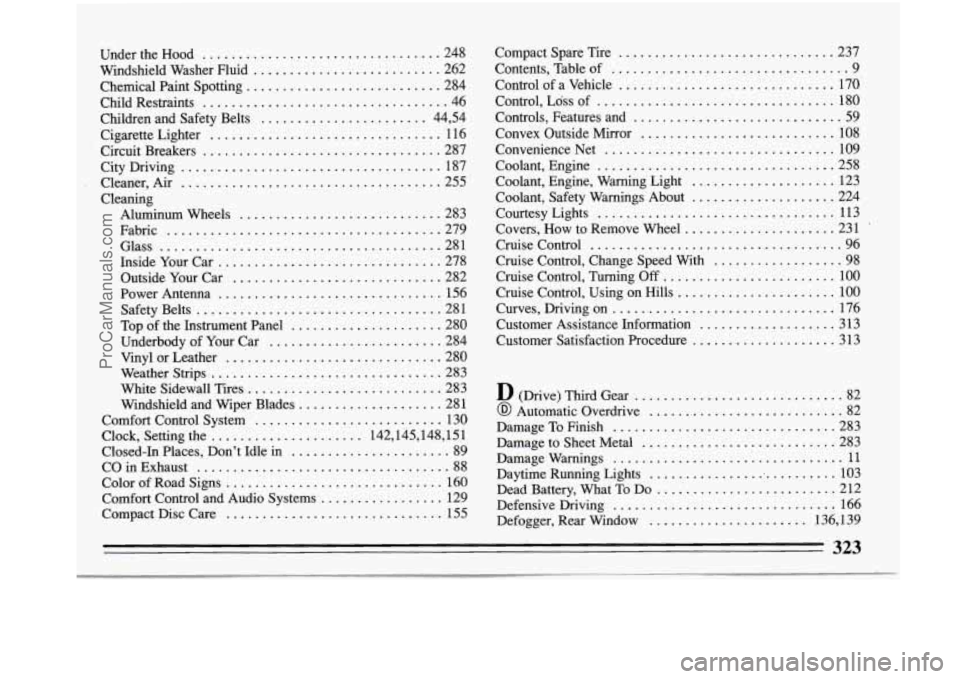
Under the Hood ............. ................... 248
Windshield Washer Fluid
.......................... 262
Chemical Paint Spotting
........................... 284
Child Restraints
.................................. 46
Children and Safety Belts
....................... 4434
Cigarette Lighter
................................ 1 16
Circuit Breakers
................................. 287
CityDriving
.................................... 187
Cleaner, Air
.................................... 255
Cleaning Aluminum Wheels
............................ 283
Fabric
...................................... 279
Glass
....................................... 281
Inside Your Car
............................... 278
Outside
Your Car ............................. 282
Power Antenna
............................... 156
Safety Belts
.................................. 281
Top of the Instrument Panel
..................... 280
Underbody
of Your Car ........................ 284
vinyl or Leather
.............................. 280
Weather
Strips ............................... -283
White Sidewall Tires
........................... 283
Windshield and Wiper Blades
.................... 281
Comfort Control System
.......................... 130
Clock, Setting the
..................... 142,145,148, 151
Closed-In Places, Don’t Idle in
...................... 89
COinExhaust
................................... 88
Color of Road Signs .............................. 160
Comfort Control and Audio Systems
................. 129
Compact Disc Care
.............................. 155 Compact Spare
Tire
.............................. 237
Contents. Table of
................................. 9
Contra1 of a Vehicle
.............................. 170
Control. Loss of ................................. 180
Controls. Features and
............................. 59
Convex Outside Mirror ........................... 108
Convenience Net
................................ 109
Coolant. Engine
................................. 258
Coolant. Engine. Warning Light
.................... 123
Coolant. Safety Warnings About
.................... 224
Courtesy Lights
................................. 113
Covers. How to Remove Wheel
..................... 231
Cruise Control
.................................. -96
Cruise Control. Change Speed With
.................. 98
Cruise Control. Turning
Off ........................ 100
Cruise Control. Using on Hills
...................... 100
Curves. Driving on
............................... 176
Customer Assistance Information
................... 313
Customer Satisfaction Procedure
.................... 313
D (Drive) Third Gear ............................. 82
@ Automatic Overdrive ........................... 82
Damage To Finish
............................... 283
Damage to Sheet Metal
........................... 283
Daytime Running Lights
........................... 103
Dead Battery. What To Do
......................... 212
Defensive Driving
............................... 166
Defogger. Rear Window
...................... 136. 139
Damagewarnings
................................ 11
323
ProCarManuals.com